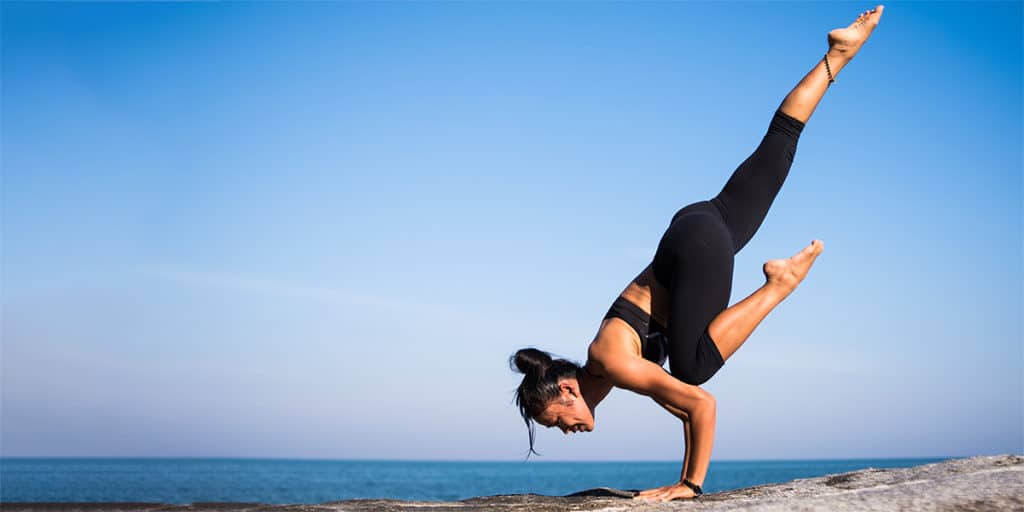Yoga is a great low-impact way to exercise for nearly everyone because its practice can be adapted for any skill and fitness level. Those who practice it on a regular basis can attest to its benefits, which are well-documented in studies, including improved flexibility, strength, balance and coordination, stress relief, and overall fitness.
Yoga has also been shown to provide back pain relief. Researchers have found that it helps reduce and manage back pain primarily by stretching and strengthening back muscles, increasing blood flow to activated areas, and ensuring a steady flow of nutrients to surrounding soft tissues of the spine. Muscle stiffness, tension, pain, and fatigue are caused by a build-up of lactic acid in the muscles due to intense use. Stretching can help to release that lactic acid – in fact, one study showed a 35% improvement in flexibility after participants did yoga for only eight weeks.1 Another study followed 313 people with chronic lower back pain who participated in a weekly class and found they were able to increase mobility more than standard medical care for their condition.2
While yoga offers indisputable benefits to overall health, there are also risks and limitations – especially for those dealing with back and neck pain. Certain poses can be problematic, specifically some of the inversion asanas (poses) which compress the neck, shoulders, and spine.
In this article, we’ll explore in more detail the yoga inversions and the benefits of using an inversion table to achieve similar benefits while also allowing the spine to decompress.

Yoga Inversions: Risks and Rewards
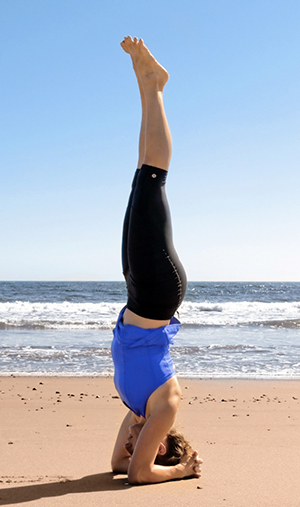
The “Sirsasana” (Headstand) and “Sarvangasana” (Shoulderstand), while offering many benefits, are not at all decompressive. In fact, they must be performed with great care due to pressure on the bones in the neck and shoulders.
Some practitioners avoid these poses due to the risk of injury, and for those with back pain, these poses are near impossible. Rather, the practice of yoga and its overall stretching benefits is best combined with inverted decompression to promote the highest overall spine and joint health. The only way to achieve this is to be suspended from hips or ankles, which is done easiest by an inversion table.
Relieve Back Pain with Perfect Pairing of Yoga and Inverted Decompression
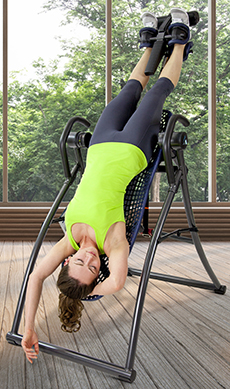
Inverted decompression with an Inversion Table elongates the spine, taking the pressure off the spinal discs and increasing the space for the nerve roots that exit the spinal canal. Less pressure means less pain. This holistic and progressive form of traction reverse loads your joints, decompressing each joint at the same weight that compresses it while upright.
A post-yoga session on the Teeter is an amazing way to achieve the ideal decompressive stretch. Warm and properly stretched, your muscles are primed to ‘release’ and allow the spine and weight-bearing joints to open up, stimulating fluid and nutrition to soft tissues and enhancing shock absorption and lubrication.
How to Introduce Inversion to Your Yoga Routine
Perhaps the best part of using a Teeter to invert is the ability to increase your angle over time instead of fully inverting right away (like with swings or inverted postures). For those just starting out, full inversions can be a bit much, but your body will adapt over time as you get used to the feeling. Start at just a 20-degree angle. Over multiple sessions, as you feel comfortable, work up to a 60-degree or even 90-degree angle. Slowly introduce the inverted stretches below into your routine:
Beginners:
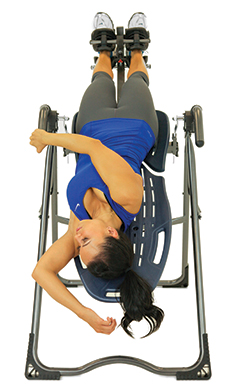
Reach with one arm straight overhead and stretch on both sides.
Light Rotation
With one arm overhead, reach the opposite arm across your body and hold onto the top of the inversion table handle.
Intermediate:
Lower Back Stretches
With one arm overhead, place your opposite hand on the inside handle. Push away while rotating your hips toward the right, creating a stretch for the lower back muscles.
Side Crunches
Reach one arm over your head with the opposite arm towards your feet. Tightening your abdominals, slide your shoulders to the left, holding the crunch for several seconds.
Advanced:
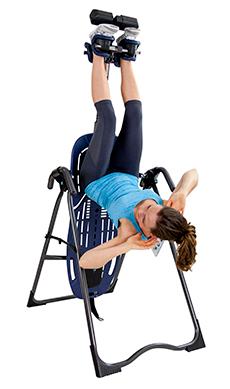
Rotate your body and grasp the table bed with both hands, using it as leverage to rotate your hips and torso for a full-body stretch.
Bridge
Place both hands over your shoulders and grip the edges of the table bed behind you. Push away, arching your back to create a bridge away from the table bed.
Sit-Ups
Bend your knees slightly and contract your abdominals, reaching your arms toward your knees and lifting your entire torso upward.
Squats
Hold onto the A-frame legs to stabilize your body. Bend your knees to move into an inverted squat.
Yoga & Teeter Inversion
Yoga has been used for centuries to improve flexibility, physical fitness, and reduce stress. By adding a Teeter to your routine, you’ll be able to unlock the greatest benefit for your spine and achieve a deeper stretch. Try including an inversion table in your regimen and see how both yoga inversion and decompression can benefit your spinal health.
Learn more about Teeter, the only inversion tables510(k) registered with the FDA. Teeter is indicated for back pain and related conditions such as:
- Sciatica
- Muscle Tension
- Degenerative Disc Disease
- Herniated Discs
- Spinal Stenosis
- Spinal Curvature of the spine due to tight muscles
- Muscle Spasms
- Facet Syndrome
Find Relief Now. Pay Later.
Now you can try Teeter in your own home FREE for 30-Days, 0% APR* with Affirm.
